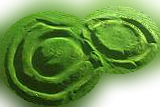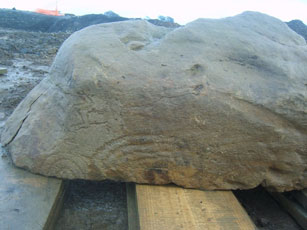|

There
is an abundance of mythological material
relating to Tara, and it is mentioned in
many of the Irish stories. The hill is
said to be named after Tea, ,
a goddess. The hill is also associated
with Maeve, a landscape goddess,
probably imported from Connaught.
Lugh
The hill is said to be a residence of
Lugh of the Long Arm. One of the
monuments, a large ringfort called Rath
Lugh, now partially ploughed out and
destroyed, is named after Lugh.
An episode from the Battle of Moytura
takes place at Tara. Lugh comes to visit
Tara and offers his services to the
Tuatha De Danann. To gain entrance he
undertakes a series of tasks, and
eventually bests everyone in the hall.
Nuada, the king asks Lugh to reign in
his place and take over the leadership
of the Dananns for the coming battle.

Cormaic Mac Airt
, the most famous king
of Tara was born by the Caves
of Kesh in
County Sligo. Cormac, who was raised by
wolves, came to Tara as a youth, and
became king by ousting his father's
killer by making a fair judgement in a
legal case.
Grainne
A large barrow, Rath Grainne
is named after Cormac's daughter
Grainne, who was engaged to Fionn
MacChmhal, but famously eloped with a
hansome young warrior, Diarmuid instead.
Outraged Fionn gave chase resulting in a
whole branch of tales, and a whole
clatter of monuments being called 'Leaba
Dairmuid agus Grainne', as the fleeing
couple had to sleep in a different place
each night.
 Fionn Fionn
Ireland's famous mythical warrior had
one of his first adventures at Tara.
Applying for membership of the Fianna,
he was given the task of keeping guard
over Tara at Samhain. Every year, a
maolvolent fire-breathing member of the
Tuatha De Danann named Ailill would
emerge from the Sidhe mound (presumably
the Mound of the Hostages) and burn
Tara. Fionn defeats the fire breathing
Sidhe-dweller and joins the Fianna,
before long becoming its most famous
leader.
St Patrick
is another figure who looms
large in the history and mythology of
Tara. The fifth century saint had a
stand-off with the High King, Laogharie
at Tara in 433. Patrick tried to convert
the King, using a shamrock to explain
the Trinity (they could have gone up to
nearby Newgrange and looked at the
Entrance stone, the earliest expression
of the Trinity on these shores). Patrick
bested the Druids of Tara in a series of
magical feats (not unlike Lugh before
him) had to flee for his life. He
forther angered the King and broke the
law by lighting his Paschal fire on the
Hill of Slane before the royal fire at
Tara.
Tara was cursed
by the christian saints
sometime around 650. There was a dispute
between the High King Dairmuid and Saint
Ruadhan: a messanger of the King had
been slain by the chieftain Aedh Guaire,
and the King wanted him executed. Saint
Ruadhan was protecting the murderer, and
in the ensuing stand off a number of
Ireland's most famous holy men laid
siege to Tara, fasting against the King
Daniel O'Connell
the Liberator, held
his largest monster rally at Tara in
1843; attendance numbers vary from
100,000 to one and a half million
people, certainly one of the largest
gatherings ever held in Ireland.
Ark of the Covenant
Between 1898 and 1901 a group called the
British Israelites dug into several
monuments during their search for the
Ark of the Covenant. This caused huge
offence to the Irish natonalists, such
as Maude Gonne, Yeats and Griffith, who
campaigned to have them stopped. They
left the Rath of the Synods in the mess
we see today. A local tale impshly notes
that all the British Israelites found at
Tara were coins placed in the dig each
night by mischievious locals.
http://www.carrowkeel.com/sites/tara/tara2.html |
![]()
![]()
![]()
![]()
![]()
![]()
![]()
![]()
![]()
![]()
![]()

![]()
![]()
![]()
![]()
![]()
![]()
![]()
![]()
![]()
![]()
![]()

![]()

![]()
![]()
![]()





 Fionn
Fionn



